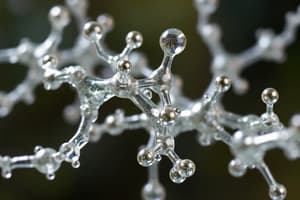Podcast
Questions and Answers
Adaptability refers to the ability of living things to survive and reproduce in their habitats.
Adaptability refers to the ability of living things to survive and reproduce in their habitats.
True (A)
Respiration is a process that only some living things undergo to create energy.
Respiration is a process that only some living things undergo to create energy.
False (B)
The hierarchy in classification of living things starts with the species and ends with the domain.
The hierarchy in classification of living things starts with the species and ends with the domain.
False (B)
Binomial nomenclature consists of a single term that identifies an organism.
Binomial nomenclature consists of a single term that identifies an organism.
A vertebrate is defined as any animal that possesses a backbone.
A vertebrate is defined as any animal that possesses a backbone.
The characteristics of living things include respiration, growth, and sensitivity.
The characteristics of living things include respiration, growth, and sensitivity.
Study Notes
Characteristics of Living Things
- Living things display several key characteristics: nutrition, movement, growth, excretion, sensitivity, reproduction, respiration, and cellular structure.
- Nutrition involves the intake of substances for energy and growth.
- Movement refers to the ability to change position or location.
- Growth signifies an increase in size or mass over time.
- Excretion is the process of removing waste products from the body.
- Sensitivity indicates the ability to respond to environmental stimuli.
- Reproduction is the ability to produce offspring.
- Respiration is essential for generating energy needed for all biological processes.
- Living organisms are made up of cells, the fundamental unit of life.
Adaptability
- Adaptability encompasses the physical traits, behaviors, and life processes that enhance survival and reproduction in specific habitats.
- Organisms can change to fit their environment, illustrating evolution and the concept of natural selection.
Respiration
- Respiration is the biochemical process by which living organisms convert food into usable energy.
- This process is vital for maintaining life functions and overall vitality.
Hierarchy in Classification
- The classification of living things is organized in a hierarchical structure: domain, kingdom, phylum, class, order, family, genus, and species.
- This hierarchy helps categorize organisms based on shared characteristics and evolutionary relationships.
Binomial Nomenclature
- Binomial nomenclature is a formal system for naming species, consisting of two parts: the genus name and the species identifier.
- This system allows for standardized identification of organisms across different languages and regions.
Vertebrates
- Vertebrates are animals characterized by the presence of a backbone or spinal column.
- This group includes mammals, birds, reptiles, amphibians, and fish, and is distinguished from invertebrates, which lack a backbone.
Studying That Suits You
Use AI to generate personalized quizzes and flashcards to suit your learning preferences.
Description
This quiz covers the essential characteristics of living things such as nutrition, movement, growth, and reproduction. It also explores concepts like adaptability and the hierarchy in classification. Test your understanding of how these traits contribute to the survival and reproduction of organisms.




